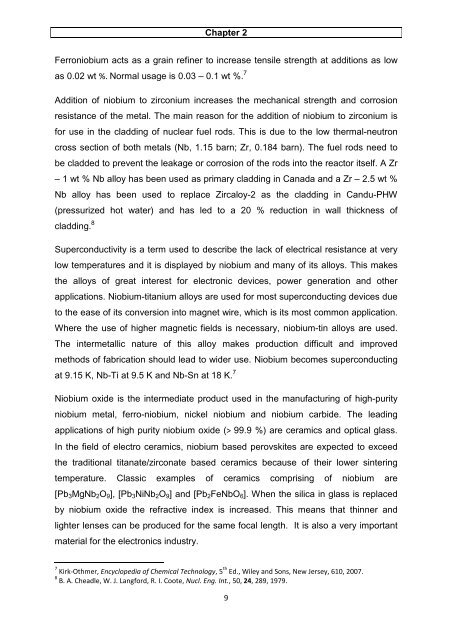A solution and solid state study of niobium complexes University of ...
A solution and solid state study of niobium complexes University of ...
A solution and solid state study of niobium complexes University of ...
Create successful ePaper yourself
Turn your PDF publications into a flip-book with our unique Google optimized e-Paper software.
Chapter 2<br />
Ferro<strong>niobium</strong> acts as a grain refiner to increase tensile strength at additions as low<br />
as 0.02 wt %. Normal usage is 0.03 – 0.1 wt %. 7<br />
Addition <strong>of</strong> <strong>niobium</strong> to zirconium increases the mechanical strength <strong>and</strong> corrosion<br />
resistance <strong>of</strong> the metal. The main reason for the addition <strong>of</strong> <strong>niobium</strong> to zirconium is<br />
for use in the cladding <strong>of</strong> nuclear fuel rods. This is due to the low thermal-neutron<br />
cross section <strong>of</strong> both metals (Nb, 1.15 barn; Zr, 0.184 barn). The fuel rods need to<br />
be cladded to prevent the leakage or corrosion <strong>of</strong> the rods into the reactor itself. A Zr<br />
– 1 wt % Nb alloy has been used as primary cladding in Canada <strong>and</strong> a Zr – 2.5 wt %<br />
Nb alloy has been used to replace Zircaloy-2 as the cladding in C<strong>and</strong>u-PHW<br />
(pressurized hot water) <strong>and</strong> has led to a 20 % reduction in wall thickness <strong>of</strong><br />
cladding. 8<br />
Superconductivity is a term used to describe the lack <strong>of</strong> electrical resistance at very<br />
low temperatures <strong>and</strong> it is displayed by <strong>niobium</strong> <strong>and</strong> many <strong>of</strong> its alloys. This makes<br />
the alloys <strong>of</strong> great interest for electronic devices, power generation <strong>and</strong> other<br />
applications. Niobium-titanium alloys are used for most superconducting devices due<br />
to the ease <strong>of</strong> its conversion into magnet wire, which is its most common application.<br />
Where the use <strong>of</strong> higher magnetic fields is necessary, <strong>niobium</strong>-tin alloys are used.<br />
The intermetallic nature <strong>of</strong> this alloy makes production difficult <strong>and</strong> improved<br />
methods <strong>of</strong> fabrication should lead to wider use. Niobium becomes superconducting<br />
at 9.15 K, Nb-Ti at 9.5 K <strong>and</strong> Nb-Sn at 18 K. 7<br />
Niobium oxide is the intermediate product used in the manufacturing <strong>of</strong> high-purity<br />
<strong>niobium</strong> metal, ferro-<strong>niobium</strong>, nickel <strong>niobium</strong> <strong>and</strong> <strong>niobium</strong> carbide. The leading<br />
applications <strong>of</strong> high purity <strong>niobium</strong> oxide (> 99.9 %) are ceramics <strong>and</strong> optical glass.<br />
In the field <strong>of</strong> electro ceramics, <strong>niobium</strong> based perovskites are expected to exceed<br />
the traditional titanate/zirconate based ceramics because <strong>of</strong> their lower sintering<br />
temperature. Classic examples <strong>of</strong> ceramics comprising <strong>of</strong> <strong>niobium</strong> are<br />
[Pb3MgNb2O9], [Pb3NiNb2O9] <strong>and</strong> [Pb2FeNbO6]. When the silica in glass is replaced<br />
by <strong>niobium</strong> oxide the refractive index is increased. This means that thinner <strong>and</strong><br />
lighter lenses can be produced for the same focal length. It is also a very important<br />
material for the electronics industry.<br />
7 Kirk-Othmer, Encyclopedia <strong>of</strong> Chemical Technology, 5 th Ed., Wiley <strong>and</strong> Sons, New Jersey, 610, 2007.<br />
8 B. A. Cheadle, W. J. Langford, R. I. Coote, Nucl. Eng. Int., 50, 24, 289, 1979.<br />
9
















